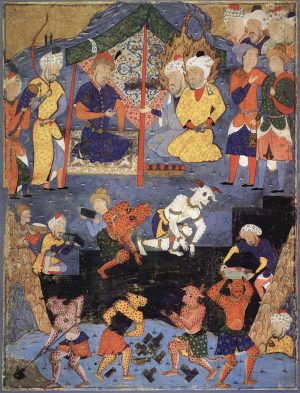The Quran is a collection of teachings from the Islamic Prophet Muhammad, compiled over twenty-three years. Muslims consider it their Holy Book from which their scriptures, laws, and commandments are written in the Arabic language.
The Islamic religion became the Persian empire’s dominant religion around the 7th century. Cyrus the Great is believed to be written in the Quran to represent the character Dhu al-Qarnayn.
Dhu al-Qarnayn
Dhu al-Qarnayn was mentioned in the Surah Al-Kahf (18), Ayahs 83–101, as a traveler who separated Gog and Magog, ancient and unprincipled tribes, from the people who they oppressed. The groups were revealed in apocalyptic sections to signal the Day of Resurrection. The Quran recounts the story of Dhu al-Qarnayn, who first travels to the edge of the Western part of the world, where he sees the sunrise. After which, he witnesses people being persecuted by Gog and Magog, who he blocks from the area by building a wall.
The figure of Dhu al-Qarnayn is also referred to as “He of the Two Horns,” which the director of the Center for the Middle East and Islamic Studies, Brannon Wheeler, stated is a likely reference to the two braids in his hair. On the other hand, the ancient scholar al-Tabari speculated that the two horns symbolized the two opposite endpoints of the world. Other historians also point to the name being inspired by the ram-god named Zeus-Ammon, who was commonly minted on the coins in the Hellenistic area of the Near East.
There are many theories about who Dhu al-Qarnayn refers to in historical accounts of the time. One of the most popular theories is that his story was derived from Alexander the Great, the ruler of Macedon, from 332 to 323 BC. The Roman and Jewish historian Flavius Josephus wrote about Alexander’s efforts to build a barrier in the Caucasus mountains to ward off the descendants of Gog and Magog. These were called the Gates of Alexander or the Caspian Gates, a structure that became one of the topics of medieval literature such as the Alexander Romance. This narrative of the wall was then passed down across the centuries before appearing in the Quran.
Cyrus the Great as Dhu al-Qarnayn
Muslim religion scholars such as Sayyed Ahmad Khan and Maulana Abul Kalam Azadhave have since proposed the view that Dhu al-Qarnayn could have been Cyrus the Great. It was first proposed by the German philologist G. M. Redslob in 1888. Advocates for this theory refer to Daniel’s vision of a ram in the Old Testament of the Bible (Daniel 8:20). The ram was described to have two horns that symbolized “the kings of Media and Persia,” a possible reference to the Achaemenid conqueror who took control of the two territories.
Additionally, the Cyrus Cylinder was also cited as evidence for this argument due to its inscriptions expressing that the Babylonian god Marduk chose Cyrus to rule over Babylonia for the good of the people. As stated in the ancient artifact, the Persian king’s religious tolerance resulted in the reconstruction and reopening of several places of worship, including temples, indicating his support of both the traditional Iranian gods and the Hebrew religion.
Lastly, a sculpted piece in a doorway pillar in the palace in the ancient Persian capital of Pasargadae displays a winged creature that bears a Hemhem crown resembling a ram’s horns. This depiction has been linked to Cyrus due to the inscriptions above it that are scattered throughout the palace, where he must have once lived in.
